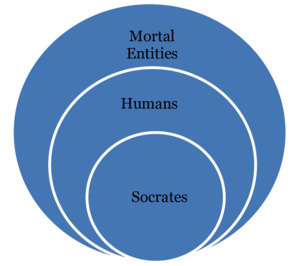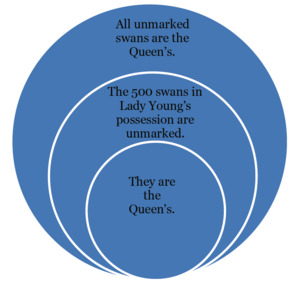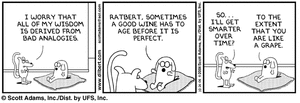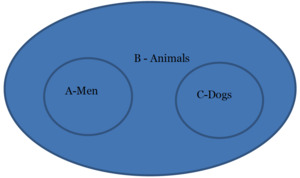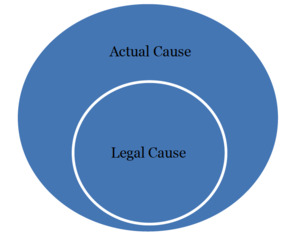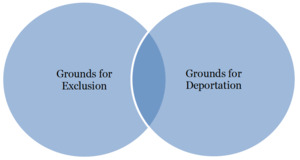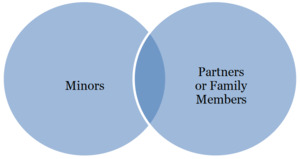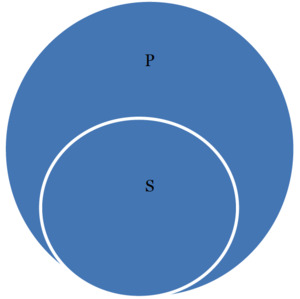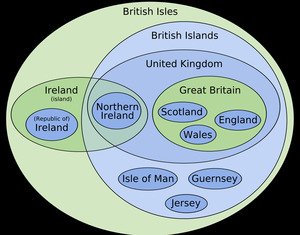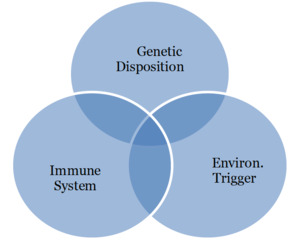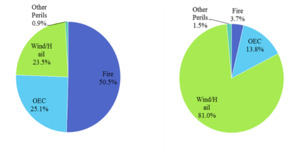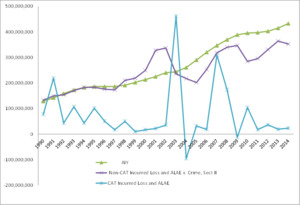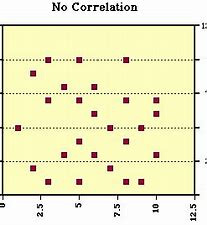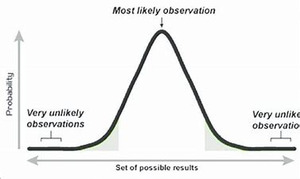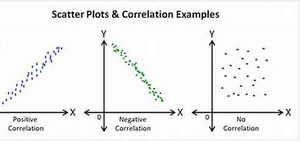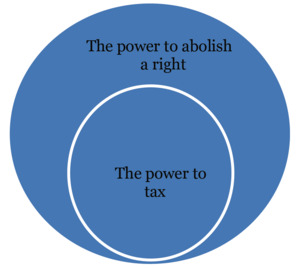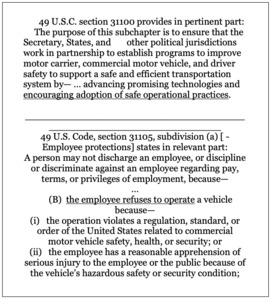INTRODUCTION
A fundamental goal of legal decision-making is that a decision is well-reasoned or makes sense.[2] Recent technological developments suggest this goal can be advanced by encouraging lawyers and judges to electronically insert images in exhibits, briefs, and decisions so that they are more intelligible. Despite this capability, the legal profession is slow to use pictures, diagrams, and other images in legal documents.[3]
Without the use of images, complex decisions are more prone to criticism for failing to grapple with the increased complexity of modern society; for being “uncandid, jargon-laden, [and] inauthentic;” and for not explaining decisions in ordinary language or justified with the expectations of “normal” people.[4] Judge Richard Posner’s view is consistent with Justice Benjamin Cardozo’s view from 65 years earlier that the language of judges “is unintelligible to those untutored in the craft.”[5]
Since the publication of The Nature of the Judicial Process, we have developed a better understanding of neuroscience, cognitive psychology, or more generally – how we think. For better or for worse, science has revealed that we think more subconsciously and intuitively rather than consciously and deliberatively.[6] For example, when we travel in unfamiliar territory, we need a roadmap to see where we are going. But when we travel back and forth to a new location a few times, we begin to store our associations subconsciously so that we don’t need to look at a map as often.
This article discusses the process of creating and using visual maps to guide legal reasoning because law and the complex facts legal professionals confront are not intuitive, and visuals are underutilized in legal writing. Part of the reason for this is that we have inherited guides to legal reasoning imbedded in judicial decisions based on literal descriptions of logic that have limited application to legal reasoning. This article seeks to overcome these literal bounds by illustrating how formal and informal logic can be described more figuratively or visually.
To make the conceptual leap from literal to visual descriptions of logic in legal reasoning, the reader is first given some background on legal reasoning within the context of how reasoning may be improved with the aid of visuals in general. Section I then describes visuals as important tools for drawing our attention to key information, such as the facts and law material to legal decisions.
Section II describes how facts and law material to legal reasoning have been traditionally described in terms of formal logic by leading jurists and scholars. They provide a verbal description of the power and limits of formal logic in legal reasoning. Section II makes the important distinction between formal logic and informal logic and their continuing role in reaching legal conclusions. Section II then begins to describe how formal logic in legal reasoning can be described figuratively or visually in a more accessible manner.
Seeking a better method of describing logical relationships in legal decisions, Section III describes attempts by judges to use the informal logic of Venn diagrams. This section gives examples of Venn diagrams in judicial decisions to introduce this important form of informal logic. Section IV concludes the article with examples of how logic in legal reasoning can be freed from the bounds of literally described logic to the less limited and more flexible realm of informal logic described with visuals. Separate sections show how the fundamental qualitative elements of legal reasoning (the law, facts, and conclusions) can sometimes be clarified visually. In addition, a separate subsection provides examples of visuals of statistical evidence. Such visuals represent a vast area of cases in which visuals are underutilized. These examples also support the truth of Justice Oliver Wendell Holmes’ prediction that a lawyer of the future is a lawyer of statistics.[7] As in law school, judicial decisions are used because they provide the best examples of legal reasoning and serve as precedents for future decisions. The visuals shown include diagrams, graphics, charts, tables and any other methods of summarizing law and facts relevant to reaching legal conclusions.
I. THE SCIENCE OF HOW VISUALS HELP US THINK MORE CLEARLY
Science explains how images can serve as important tools for consciously drawing our attention to key information, such as the facts and law material to legal reasoning. In recent years, science has illuminated how our brains and emotional processes function to regulate our decision-making. Our understanding of the brain and how it functions has progressed rapidly due to advances in many fields of neuroscience[8] and psychology. Based on this foundation, neurological investigations expanded into cognitive psychology and decision-making. In 2005, Malcolm Gladwell summarized how our brains unconsciously process information in the blink of an eye in Gladwell’s book, Blink.[9] This knowledge was applied to judicial decision-making in the 2007 article, Blinking on the Bench: How Judges Decide Cases.[10] Additionally, Nobel Laureate, Daniel Kahneman, expanded understanding of our thinking processes by separating the thinking we perform automatically from the thinking we perform consciously; for example, when we travel to a new place as discussed above.[11]
When we are traveling in unfamiliar territory, we use maps to consciously deliberate over which fork in the road to take to get to our destination. Judges do the same thing to avoid taking a wrong turn or to avoid admitting evidence improperly. Judges like anyone else may commit errors by relying on their intuition, instead of pausing to deliberate.[12] A growing body of research suggests that more consciously deliberating is critical to avoiding unjust or erroneous legal outcomes that may arise from unconscious associations or implicit bias.[13]
A concrete example of how unconscious associations overly influence legal outcomes is the phenomenon known as anchoring.[14] It occurs in the context of making numeric estimates when a starting initial value “anchors” the subsequent estimation process in a way that gives the anchor greater influence on the final estimate than it should have.[15] For example, one study demonstrated that the amount of a demand in a prehearing settlement conference can anchor a judge’s assessments of the appropriate amount of damages to award.[16] Other well-studied categories of error and bias that may arise in legal proceedings include the undervaluation of statistical information[17] and hindsight bias.[18]
Errors in decision-making also arise by not separating the process of collecting information from the process of evaluating it.[19] If judges allow themselves to make decisions based on limited information, they allow their unconscious associations to merely function as a machine for jumping to conclusions.[20] In other words, the predictions of our automatic thinking must be tamed by using our more deliberate thinking to consciously evaluate our assumptions.[21]
In a provocative example, the U.S. Supreme Court intimated at the power of visual information when Justice Potter Stewart attempted to define obscenity by referring only to his implicit understanding of what is obscene by pronouncing “I know it when I see it.”[22] The Supreme Court did not include pictures of nude lovers in the French film, Les Enfants, in its decision. They left that to our imaginations.
Contrary to the views of René Descartes, we don’t only know what we think consciously.[23] As civilizations shifted from so-called primitive societies to presumedly more intelligent ones, scholars tended to define intelligent thinking as separate from our senses, including our visual sense.[24] Now, scholars and researchers realize that images are not only translations of mental concepts, “but the very flesh and blood of thinking itself.”[25]
One third of the brain is devoted to vision.[26] It includes the physical sense of seeing and interpreting what we see. For this reason, people who regain eyesight later in life cannot understand the images they perceive because their brains have not developed the concepts needed to interpret them.[27] As we think, visual images serve as signs and symbols we use to form abstract concepts. Such concepts include our depth perception and logic, which may be visualized.
Similarly, images can help thinkers to focus on what is most relevant by dismissing from visibility the signals from the noise.[28] In such a way, concepts are formed by visually perceiving their relevant features.[29] An effective visual can be as simple as a group of shapes that are labelled in a way to put them into the context in which they arise. Appropriate shapes combined with text serve to clearly present complex information and to symbolize concepts. Concepts can more persuasively guide us in figuratively drawing conclusions when we understand the logic of how arguments combine to form reasonable conclusions.[30]
One challenge is that not all judges and lawyers have a thinking style or personality that values logic.[31] However, this barrier can be overcome by conveying logical concepts visually in a way that appeals to our senses or intuition. Another barrier to understanding legal decision-making is understanding what makes it reasonable in the first place. Fortunately, over time scholarship on legal theory paints a clearer picture of reasoning in law and the role of logic in it.[32]
II. LEGAL REASONING AND THE ROLE OF FORMAL LOGIC
Lawyers and judges often disparage an opposing position as illogical.[33] But for such an argument to be persuasive, lawyers should know how logic strengthens legal conclusions or reveals fallacies in them. To help clarify the use of logic in legal reasoning, this section starts by discussing the two fundamental formal types of logic: deductive reasoning and inductive reasoning, including the inductive forms of reasoning by analogy and generalization. It is important to understand what formal logic actually is because the application of such forms to legal reasoning can be very powerful and very limited.
When lawyers claim something is illogical, they are usually speaking of logic in its informal sense, so this section distinguishes the two. However, people still don’t often understand the point because the argument often involves a lot of details. Since those details may be better understood visually, this section begins to describe how logic in legal reasoning can be described figuratively or visually in a more accessible manner.
To begin illustrating these points, let’s look at a common example. When one receives a ticket for running a red light, the citation says little about what evidence the officer used to reach that conclusion or how the law logically applied. This is due, in part, because the law is more complicated than one would intuitively think. California law prohibiting drivers from running a red light governs such circumstances by stating as follows:
A driver facing a steady circular red signal alone shall stop at a marked limit line.[34]
The statute provides rules for when a sidewalk is present and for when one is not. In either case, a witness may describe whether a red light violation occurred best by describing where the car was in the intersection when the light turned red using a diagram.
Laws may also conflict. A complex array of laws may apply to a dispute. Or law may not have been written to resolve disputes over unforeseen circumstances or ones in which legislators have been unable or unwilling to act. In fact, legislators may leave some ambiguity in the law to give judges the discretion to apply it to unforeseen circumstances. In such cases, lawyers angle to convince judges to accept their view of the purpose[35] of the applicable law and facts in a narrative that persuades judges of the justice of an outcome most favorable to their client.[36] Llewellyn describes this as an ad hoc approach to logic, in which one searches not for a rule or major premise that holds “at large,” but for one that applies to the “the matter at hand.”[37]
Where the law does not apply directly to a legal dispute, judges characterized as conservative will take a more constrained view[38] and hold that it is the role of the legislature to change law, not judges. A good example of such a constrained view is Judge (now Justice) Neil Gorsuch’s opinion in the case of Transam Trucking v. Administrative Review Board, where his dissent was based on the strict interpretation of a few words.[39] When the need for reform is clearer, judges willing to take a more dynamic view of their role[40] have changed public policy from the bench based on widely shared values.[41] A good example of such a dynamic view is provided by the era of prison reform instituted by federal courts from 1960 to 1986 without guidance from legislative enactments.[42]
However judicial views, approaches, or philosophies are characterized,[43] judges have the choice to equitably exercise their discretion under circumstances ranging from those in which the law is clear to those in which applicable law is unclear or does not exist.[44] Even in cases where the law is not clear, logic may serve to limit judicial discretion because a decision can be overturned when a judge’s exercise of discretion exceeds the bounds of reason or is clearly against the logic of the circumstances.[45] To understand such bounds, let us try to visualize it.
As a form of persuasion or rhetoric, Aristotle characterized what was later described as reasoning[46] as involving logic (logos), emotions (pathos), and ethics (ethos).[47] Other articles discuss pathos-based modes of persuasion.[48] This article focuses on the fundamental logos of persuasion or reasoning “in a logical, lawyer-like manner from the premises adopted to a sound conclusion.”[49]
The use of terms of logic to describe reasoning in law continues to this day because logic is understood more broadly to include other informal tools of thorough and effective reasoning.[50] In The Nature of the Judicial Process,[51] Cardozo describes how to infer rules and principles and to reach conclusions using terms of logic. But Cardozo left open the question of how much to use logic or how far to seek logical consistency.[52] This question is not unique to legal reasoning. In any process of reasoning, one must determine how far each step needs to be carried. “No iron-cast rules can be laid down. Each case has to be dealt with as it arises, on the basis of its importance and of the context in which it occurs.”[53] In this way, law evolves in the most reasonable way by subjecting each fact, legal principle inferred, and conclusion to critical analysis and review through a process of trial and error or conjecture and refutation.[54] So let us now look at the rules of inference known as logic[55] we intuitively use every day, including deduction and the inductive forms of analogy and generalization.[56]
A. Deductive Reasoning
Formal deductive logic consists of a series of propositions known as a syllogism, including a major premise, a minor premise, and a conclusion often shown in the form below in this classic example:
Major premise: All humans are mortal.
Minor premise: Socrates is human.
Conclusion: Therefore, Socrates is mortal.
Given that the premises are true and the deduction is in a valid form, the conclusion is sound. For visual learners or for people with more intuitive or sensing personality types, the soundness of this conclusion may be easier to perceive as follows:
One example of formal deductive logic in its classic form arose in The Case of Swans.[57] In this case, a dispute arose between Queen Elizabeth I of England and Lady Joan Young, who possessed 500 unmarked swans. The decision is guided by the royal edict (the major premise) that because swans are royal, all wild unmarked swans belong to the royal family. In syllogistic form, the logic of this decision could be described as follows:
All unmarked swans are the property of the royal family.
The 500 swans in Lady Young’s possession are unmarked.
Thus, they (the 500 swans in question) belong to the Queen.
Symbolically, this logic could be depicted as follows:
The Case of Swans is an example of a pattern in which the facts logically fit within the law.
The other common form of a valid deductive conclusion arises in cases where the facts do not fit within the law or legal premise. For example, in Seabrook v. Wittschen,[58] the judge included the following syllogism to explain the decision:
Major premise: Only land shown on the map is zoned.
Minor premise: The subject property is not on the map.
Conclusion: The subject property is not zoned.
Or as the judge stated less formally, the only logical conclusion that could be derived from the record was that the property was not rezoned because it was not shown on the map accompanying the most recent zoning ordinance.
The use of deductive logic in legal decisions is well-documented. But explicit examples of it, in its technically valid formal form, are difficult to find because it is difficult to frame a legal issue in the form of a syllogism. More commonly, deductive logic underlies “the vast majority of cases in which there is little doubt.”[59] For example, a red-light violation of California Vehicle Code (CVC) section 21453, subdivision (a) could be written in the form of a syllogism as follows:
A violation of CVC section 21453, subdivision (a) occurs when a driver approaching a red signal light does not stop before an intersection.
Driver A did not stop before a certain intersection.
Thus, Driver A violated CVC section 21453.
Due to its persuasive effect, early American jurists used formal logic as a tool to elevate the certainty of their reasoning.[60] But the conclusions of deductive logic are only valid for a limited set of information, unlike the universe of facts of legal disputes.
In addition, a legal conclusion is determined more by the choice of the applicable law than its logical form. For example, in TransAm Trucking,[61] Judge Gorsuch reached his dissenting opinion by choosing to hinge it on the one phrase related to whether the employee refused to operate a vehicle. In contrast, the majority centered its opinion on a more expanded view of the law that included broader safety considerations. For this reason, Justice Oliver Wendell Holmes declared, “the life of the law has not been logic: it has been experience.”[62] But Holmes did not intend for logic to be disregarded in its entirety. As Holmes explained in The Path of the Law, “law is a logical development, like everything else.” It just is not “the only force at work in the development of the law.”[63]
Given the possibility of less than accurate facts in almost any legal matter, deductive legal arguments serve as informal or apparent syllogisms. Or where judges find law to be applicable, the applicable legal rules may serve as the major premise of an argument with the facts serving as a minor premise leading to a deductive conclusion. What is most important is which combination of law, facts, and the conclusion fits a case best. Thus, the underlying structure of legal arguments may be analyzed and clarified by visualizing how the facts of a case fit within the most applicable legal rules.
Once applicable rules and principles are inferred, legal reasoning becomes deductive in an informal sense based on the probability that a conclusion is the best one.[64] One may also use analogies to reach a conclusion. In other words, legal reasoning may involve an interplay of analogy, generalization, and informal deduction to reach a conclusion.[65] This interplay allows judges and lawyers to address complex issues involving long chains of propositions.[66] And in this way, formal logic can strengthen legal conclusions or reveal fallacies in them.
In some cases, syllogisms and accompanying drawings would not simplify a decision to make the decision more persuasive. For example, in Seabrook, discussed above, the court simply deduced that the property was not zoned because it was not included on the last zoning map. Such reasoning could not be captured symbolically because the factual premise is the non-existence of Seabrook’s property on the zoning map. The best way to depict this decision would be to simply print a copy of the zoning map for the City of Folly Beach showing where the Seabrook property would be if it were shown on the most recently enacted zoning map.
The courts in The Case of Swans and Seabrook inferred a legal premise and deductively inferred conclusions based on the facts being within the boundary of the law inferred. Today, judges rarely incorporate syllogisms in decisions.
B. Reasoning by Analogy
Reasoning by analogy is the most common form of formal logic used in law. Reasoning by analogy is also the type of logic most familiar to us in everyday life.[67] We use it so frequently that we hardly see it as a form of reasoning.[68] For example, from a very young age we learn to analogize by simply comparing two or more things. If two or more things are similar in some respects, we infer that they may be similar in other respects. But one can draw different conclusions from the same similarities.
The persuasiveness of an analogy can be formally evaluated by quantifying similarities and other measurable properties and representing the degree of similarity by the degree to which lists of properties overlap.[69] The more overlap there is between the elements of a pertinent statute or a precedent and those in a case, the more significantly a law can guide a decision. Or the less overlap there is between a previous case and facts, the more a previous case can be distinguished. For example, in MacPherson v. Buick Motor,[70] discussed and visualized below, Cardozo found Buick Motor to be liable for a defective wheel due to two elements the MacPherson case had in common with three other cases.
These fundamental relationships of overlap or similarity can be described using overlapping circles or Venn diagrams,[71] such as those below which are available in word processing programs like SmartArt.[72] As all lawyers know from law school, such informal reasoning by analogy is how common law evolves from case to case, as judges refine factors of comparison to be followed in future cases. Factors or tests of comparison may also be codified in statutes or regulations to guide reasoned decision-making where insufficient precedents exist. This is often the case in many areas of administrative law. For example, for regulations classifying employers for the purposes of determining rates of workers’ compensation insurance in California, the regulations specifically list the factors to be used in classifying employers by analogy.[73]
C. Generalization
Generalization is the other form of inductive reasoning that is such an instinctive thought process that it can be performed intuitively without thinking of it as a form of logic. Generalization involves the process of forming a conclusion from a variety of particular pieces of information.[74] Generalizations serve to sharpen our understanding of concepts by concentrating our minds on a few essentials.[75] In legal reasoning, such information may take the form of facts or precedents. For example, the scene of a naked couple making love without showing anything below the neck, except for backs, arms, and legs has stood for over 50 years as a standard for what is not obscenity.[76] Like analogy, the strength of a generalization may be formally analyzed based on a number of statistical criteria.[77] A generalization based on particular facts may be stronger depending on the following: a) the larger the size of the sample or amount of evidence relative to the size of the subject about which one is generalizing, and b) the similarity between the sample and the object of generalization.[78] Such criteria may even be codified into standards, as they are in the actuarial profession.[79]
Judges make legal decisions by drawing lines distinguishing the relevant facts and legal principles in one case from those in other cases or statutes. Such reasoning is not easily categorized in terms of formal logic. Such reasoning is easier to criticize for not meeting its own standards, for example, by describing a conclusion as the product of a poor analogy, a hasty generalization, or an unsound deduction based on insufficient evidence and conscious or unconscious biases.
D. Visualizing the Bounds of Reason
The logic underlying legal reasoning is easier to understand visually than with the literal rules of formal logic. For example, in Spencer v. Texas,[80] the U.S. Supreme Court awkwardly held that prior crimes may be proven in the course of the guilt phase of a trial in order that the jury may also assess whether a defendant, if found guilty, should be sentenced to an enhanced punishment under recidivist statutes because “prior-crimes evidence may be admitted at the guilt phase of a trial where the admission serves a valid purpose and since the purpose of recidivist statutes is valid.”
Consequently, Chief Justice Earl Warren wrote in dissent that “the Court’s premises do not combine to justify its far-reaching result. I believe the Court has fallen into the logical fallacy sometimes known as the fallacy of the undistributed middle, because it has failed to examine the supposedly shared principle between admission of prior crimes related to guilt and admission in connection with recidivist statutes. That the admission in both situations may serve a valid purpose does not demonstrate that the former practice justifies the latter any more than the fact that men and dogs are animals means that men and dogs are the same in all respects.”[81]
Here, Justice Warren used the following formal syllogism as an example of the fallacy of the undistributed middle[82] to argue that the majority’s reasoning was illogical:
All men (A) are animals (B).
All dogs (C) are animals (B).
Therefore, all dogs (C) are men (A).[83]
We obviously know the first two statements do not lead to the conclusion. But it is easier to see why they don’t by visualizing the logic the statements are trying to convey in Figure D. It illustrates that just because all “A” are “B” and all “C” are “B,” it does not follow that there is any connection between “A” and “C,” or dogs are not men.
This is an example of a judge attempting to claim an argument is illogical using the technical terms of formal logic instead of describing the argument with the aid of visuals.[84] In the Venn diagrams in this article, each shape represents a proposition. When they are viewed together, they represent the conclusion drawn from the other two propositions depicted. These diagrams serve as effective images in legal reasoning because our perception of what the shapes contain coincides with the relationship between the propositions and conclusions in deductive reasoning.
Over time, the definition of logic has evolved from a formal description of terms of argument to include a broader, more informal definition that refers to the “interrelationship or sequence of facts.”[85] The adage that a picture is worth a thousand words reflects this common-sense reality. Whether one thinks fast intuitively or slowly deliberates,[86] images can help to simplify complexity in decision-making. This is important because in complex cases involving thousands of pages of exhibits and transcripts, judges don’t have time to fully or repeatedly review the record. Judges can avoid such inefficiency by trying to conceptualize the applicable law first. Then judges can determine how the facts fit within the parties’ arguments as the case proceeds.
To address complexity, Posner recommends a variety of approaches to make cases come alive. More specifically, to help develop a strong sense of the facts as well as a firm grasp of the applicable law, Posner recommends, “wherever possible, [to] use pictures, props, maps, diagrams, and other visual aids in [a] brief.”[87]
Posner’s recommendations for confronting legal complexity are also consistent with descriptions of legal reasoning that recognize its visual nature. Whether a legal dispute is ultimately determined by existing law or other principles, the range of law can be determined visually by mapping relationships between the circumstances envisioned by law and the pertinent facts that may apply. Recently, judges have started to describe relationships between complex, abstract concepts using Venn diagrams.
III. THE INFORMAL LOGIC OF VENN DIAGRAMS IN JUDICIAL DECISIONS
To try to describe the logical relationship between two concepts without formal logic, judges have begun using or referring to Venn diagrams.[88] This section gives examples of Venn diagrams in judicial decisions to introduce this important form of informal logic.
The appearance of Venn diagrams to depict informal logic in judicial decisions in the U.S. in the last few decades is not surprising given the introduction of Venn diagrams in K-12 education in the U.S. in the 1960s. Venn diagrams were introduced in American schools as set theory[89] as part of the “new math” movement following the launch of the first artificial earth satellite known as Sputnik by the Soviet Union.[90] As a result, the symbolic logic of Venn diagrams reached high schools in time to influence a new generation of judges, including Justice Elena Kagan.
Instead of using formal terms of logic, judges schooled in symbolic logic began to conceptualize legal relationships by visualizing and drawing them in cases to describe the same fundamental relationships of inclusion and exclusion described by Venn. Such cases involve statutory schemes common to administrative hearings, such as those that appear on the docket of this author. They also involve complex law and subject matter, as shown in the examples that follow.
In what may be the first attempt by a court to use Venn diagrams, the judge in Mellon Bank v. United States[91] included the Venn diagrams below in its opinion to explain the proper interpretation of a statute by conceptualizing the relationship of its two key requirements as either overlapping, not overlapping, or including one within the other. See Figures 1-3 below, respectively. Mellon Bank is a complex tax refund case where the plaintiffs sought miscellaneous itemized tax deductions from the gross income of a trust estate for payments to private investment advisors that purportedly qualified for I.R.C. section 67(e)(1). The Plaintiffs argued that the second statutory requirement added nothing to the meaning of this section, as if the second requirement was completely included within the first requirement, as in Figure 3, below.[92] But the court opined instead that the proper interpretation of I.R.C. section 67(e)(1) is represented by Figure 1, where circumstances exist that satisfy both statutory requirements.[93]
Lacking cites in the legal literature to explain the relevance of set theory[94] to the court’s reasoning, the court in Mellon Bank[95] described set theory in the footnotes explaining its diagrams. The court also explained that Venn diagrams are an effective way to detect and understand whether a proposed interpretation of a statute renders a particular provision superfluous.[96] Ultimately, the court’s diagrams illustrated both the interpretative choices and the court’s reasoning. However, note that Figures 1-3 in Mellon Bank could have been improved with better textual labelling to link the figures to the context of the case.
Although judges occasionally have referred to Venn diagrams without drawing them,[97] using pictures, when possible, is more helpful because law, facts, and how they combine to reach a conclusion can be difficult to conceptualize. For example, to help convey the amorphous concept of proximate or legal cause to a jury, the court in Stewart v. Federated Department Stores, Inc.[98] affirmed that the trial court could use a Venn diagram in an instruction to explain the meaning of legal cause.[99] The trial court stated that legal cause can be portrayed pictorially as a Venn diagram, with a circle representing actual cause completely subsuming the smaller circle representing legal cause.[100] In other words, the relationship between legal cause and actual cause may be understood as follows:
Such diagrams are a symbolic form of logic using sets to express the same relationships of containment described in deductive reasoning or, more simply, the relationships between concepts and the parts they contain.
IV. THE USE OF VISUALS TO BETTER COMMUNICATE INFORMAL LOGIC IN LEGAL REASONING
Visuals are a realistic tool to help visualize the inherent logic of legal reasoning in its informal or broadest sense in a way that makes the law come alive.[101] Visuals can perform this function by representing the fundamental elements of reasoning separately and together. This section gives examples of how these qualitative elements can be visualized separately and together to draw conclusions. A separate subsection is provided below to discuss how visuals can be used to summarize statistical inferences used to find facts or to support legal conclusions.
Arguably, the question of whether to use visuals in legal writing has been “asked and answered,” affirmatively.[102] This is not a formalistic endeavor that adheres to strict rules or that has a particular set of terminology. Rather, diagrams are a realistic tool to help visualize the inherent logic of legal reasoning in its informal or broadest sense in a way that makes the law come alive.[103]
The images used in this article provide only a sample of the possible methods that may be used to visually represent law, facts, and their relationships in legal decisions. The challenge is to determine how visual images and text can unite to accurately reveal essential elements of legal reasoning that would be more difficult to understand with words alone.
A. Visualizing the Range of Applicable Law
Before judges write decisions, they cope with a potentially overwhelming array of information by conceptualizing and categorizing it. The categories take the form of lines of precedent and a variety of methods of viewing the facts of a case and their context. The consequences flowing from how this information is organized are enormous. Llewellyn described the pivotal nature of a judge’s choice of law in determining or justifying a decision.[104] More recent scholarship highlights the importance of making such choices more consciously.[105] In other words, once a judge determines the law applicable to a case and makes necessary findings of fact, the task of inferring a conclusion is close at hand. Consequently, one of the most helpful uses of diagrams in legal decision-making may be to make the applicable law more visible, as others have suggested.[106]
In Judulang v. Holder,[107] the Supreme Court referred to Venn diagrams to help readers conceptualize the issues in dispute,[108] but the decision would have been clearer if it actually inserted the overlapping Venn diagrams in Figure F. The issue was whether the Attorney General could hinge a deportable alien’s eligibility for discretionary relief on the chance correspondence or overlap between the statutory grounds for exclusion and the grounds for deportation.[109] Comparing the two abstract statutory categories to understand the attorney general’s argument is a difficult task. To assist the reader, the diagram in Figure F could have been inserted to better visualize the overlap between the two statutory grounds used in the comparable-grounds approach argued by the Attorney General.
The Court referred to Venn diagrams to conceptualize the weakness of the Attorney General’s argument based on the interrelationship between the overlapping criminal statutes at issue. The Court wrote that “the resulting Venn diagrams have no connection to the goals of the deportation process or the rational operation of the immigration laws.”[110] With this schema in mind, the reader can better focus on the narrative regarding how the comparable-grounds premise arbitrarily denied aliens the right to seek relief from deportation.
Similarly, in State v. Weatherell[111] the Supreme Court of Montana could also have effectively illustrated the issue in dispute with Venn diagrams. In this case, the trial court convicted Mr. Weatherall of assault on a minor and assault on a partner or family member for striking his girlfriend’s two-year-old son and causing severe bruising.[112] A separate sentence was imposed for each conviction.[113] The defendant appealed the assault on a minor conviction based on the constitutional and statutory prohibition of being put in jeopardy twice for the same offense because the State of Montana also convicted him of assault on a partner or family member.[114] A Montana statute specifically prohibited someone from being prosecuted for more than one offense if one is included in another.[115]
The court justified dismissing the appeal of the second conviction because the conviction of assault on a minor merely overlapped with the conviction of assault on a partner or family member, but was not “included in” assault on a partner or family member.[116] The court stated that double jeopardy requires a relationship of charges that can “be illustrated by a Venn diagram of concentric, rather than merely overlapping circles.”[117] To be clearer, the judge could also have used the diagram in Figure G to illustrate whether one charge completely included the elements of the other category. And Figure G clearly shows that not to be the case. This figure helps one understand the essential issue. Can the category of minors include all partners or family members? Or can the classification of all partners or family members include all minors that are not partners or family members? Because the charges based on these categories do not completely include the other, the court logically found no double jeopardy.
B. Visualizing Law Involving Logical Words
Visuals can help conceptualize legal issues any time logical words, such as “and,” “or,” “not,” “no”, “any,” “all,” “some,” and “including,” are used to structure rules. Such visuals can express the same relationships of containment, overlap, and exclusion described by deductive reasoning to more clearly understand the subjects such terms connect. Linguists use diagrams to understand such semantic problems in the same way because logical words are elements of language that may be best understood visually.[118]
One can use images to visualize the same relationships to more clearly understand the subjects such terms connect. For example, The Case of Swans involved the universal affirmative proposition describing the ownership of “all” unmarked swans.[119] This proposition can be described more generally as “all S are P,” and drawn simply as follows:[120]
All S are P:
The other categorical proposition common in law is the universal negative proposition. This proposition can be described more generally as “no S are P,” and drawn simply as follows:
No S are P:
One frequent source of ambiguity involves the use of the term “including” when the use of the term “including” in a statute or a case does not clearly state the subject matter the term is intended to contain. For example, in Hassan v. Mercy American River Hospital,[121] the California Supreme Court had to determine whether the term “any person” in a statute included non-profit entities in the context of a physician suing a hospital for defamation.[122] In support of its conclusion, the court clarified that “including” is intended to be used as a term of enlargement.[123] Regardless of whether one agrees that a legal entity should be viewed as a person, the court’s reasoning in Hassan is based on non-profits being viewed as a subset of persons. In any case, when practical, courts may draw their conclusions by including images to illustrate the subject matter the law attempts to include within another.
To illustrate relationships between a multiplicity of variables, mathematicians and logicians, such as Venn, described logical relationships between propositions using a variety of visuals. The closed lines in them represent how groups of concepts relate to each other and may include more than two or three shapes. Legal proceedings frequently adjudicate definitions, which may be logically viewed visually. For example, to help understand terms associated with the British Isles, one can learn a lot from the following:[124]
The use of two or three circles popularized by Venn were originally developed by Leonhard Euler, who described more complex relationships with many more shapes.[125] Consequently, virtually any shapes may be used to visualize the boundaries of material law and whether facts fit within them.
C. Visualizing Complex Material Facts
Images are most commonly used in legal documents, including in briefs filed in the author’s cases simply to enter evidence into the record, especially when the information is complex. From the record, judges find facts inferred from primary facts such as physical evidence or indirectly through perceptions introduced in documents or direct testimony according to a standard of proof.
Images in legal argument and decision-making avoid the awkwardness of language by allowing persons to make inferences more directly. For example, charts and outlines help lawyers organize information in preparation for trial.[126] Parties frequently offer photographs into evidence, but they are often left out of judicial decisions. But this practice is beginning to change. For example, in Viscontini v. Secretary of Health and Human Services,[127] a special master included in his decision the image in Figure J.[128] This diagram serves to illustrate three factors that must coincide to cause Crohn’s disease.[129] This was relevant because the plaintiff sought compensation under the National Vaccine Injury Compensation Program based on the theory that a hepatitis B vaccine caused petitioner’s Crohn’s disease.[130]
Other professions, from science and mathematics to literature, use images to illustrate information from which people may draw factual inferences.[131] As a result, word processing software, such as Microsoft Word, now provides a variety of methods for inserting scalable diagrams, shapes, charts, and pictures, such as those used in this article.
I have inserted diagrams in my own decisions to illustrate central factual findings. With In the Matter of the Application of State Farm General Insurance Company,[132] I used pie charts in Figure K to illustrate differences in catastrophic insurance losses nationally and in California.[133]
I inserted Figure L[135] in the State Farm decision to illustrate the instability in California insurance losses due to fires in the previous 25 years. Both visuals were relevant to determining whether the data prior to 2015 was sufficient to establish an increasing trend in wildfire losses. And both of these visuals were inserted in trial briefs.
D. Visualizing Statistical Inferences
The focus of this article is how to better communicate logic in legal reasoning using visuals. Up to this point, the visuals have focused on logical relationships of containment, overlap, and exclusion that are quantitative. The focus of this section is on visualizing generalization that are inferences from evidence or data that can be quantified. Recall from Section II.C that a generalization is merely an inference formed from a variety of particular pieces of information. Since the collection, analysis, and interpretation of data is the subject of statistics, people describe such logical inferences as statistical inferences. In 1897, Oliver Wendell Holmes Jr. wrote that “for the rational study of the law [,] the blackletter man may be the man of the present, but the man of the future is the man of statistics and the master of economics.”[136] Some people argue that the future Holmes foresaw is still arriving.[137] But a review of the thousands of appellate cases involving statistical evidence shows the future Holmes envisioned has already arrived. Furthermore, the visualization of data has a long history.[138]
Unfortunately, many lawyers and judges are behind the curve in terms of representing statistical information effectively in legal writing. For example, in Board of County Commissioners of Park County v. Water Quality Control Commission of the State of Colorado,[139] the court found the Commission’s water quality standards allowing increased levels of cadmium and lead to be based on insufficient statistical evidence.[140] The standard practice for summarizing variations in data is to graph it.[141] But in this decision, no diagram was provided to illustrate the variation in such evidence. In contrast, the chapter on statistics in the federal Reference Manual on Scientific Evidence uses graphs extensively to describe statistical data and inferences that may be drawn from them.[142]
In Water Quality Control Commission, one of the central facts in the case was that “all parties to the rule-making proceeding agreed that the data concerning cadmium and lead were severely skewed rather than normally distributed.”[143] To illustrate how the data was skewed, the court could have simply included a scatterplot diagram showing the variability in the measurement of cadmium and lead in the South Platte River. Figure M is an example of a diagram showing a lack of correlation.
Next, the court could have illustrated its acceptance of a certain statistical methodology and the requirement that certain data be normally distributed by including a diagram of normally distributed data, such as the diagram in Figure N.[144] Such scientific statistical methodology has been long accepted by courts,[145] but judges shy away from representing such evidence visually.
Understanding the significance of statistical evidence is important because statistical evidence can determine the outcome of a variety of cases, including discrimination cases, anti-trust cases, and a variety of torts cases.[146] In such cases, judges determine whether the evidence is sufficient for experts to make findings as in the water quality case above. In addition, judges are called upon to admit expert testimony, make findings of fact, and ultimately infer legal conclusions based upon statistical evidence.[147]
The problem is particularly acute in tort cases where the issue is whether exposure to something in the environment has caused harm.[148] The challenge is that some data may demonstrate a correlation, but more is needed to infer legal causation.[149] The strength of a correlation can be described using various complex terminology, and it can be summarized by graphs such as those in Figure O.
Experts use such scatter diagrams to summarize correlation coefficients and regression lines to illustrate relationships between variables.[150] Trial court judges have discretion to admit or exclude such evidence, as in cases where the issue is whether there is a causal relationship between exposure to chemicals in the environment, such as PCBs, and cancer.[151] Visualizing such evidence can be important to judges and lawyers who must interpret such expert knowledge. Otherwise, left to their intuition, judges are likely to make inferences incorrectly.[152]
E. Visualizing Combinations of Law and Facts
Ultimately, any effective legal analysis must demonstrate how legal conclusions involving certain case facts are determined by the applicable law in a logical manner. In some cases, such analysis may be visualized.
A classic example is Cardozo’s decision in MacPherson v. Buick Motor Co.[153] on product liability. In MacPherson, the plaintiff was thrown out of a car after a defective wheel collapsed while he was driving.[154] MacPherson sued the manufacturer for damages stemming from the defective wheel even though the plaintiff purchased the car from a dealer.[155] The legal question was whether the defendant owed a duty of care and vigilance to anyone but the immediate purchaser.[156]
Cardozo may have sat at his desk and visualized the facts from the cases in Figure P in which judges found liability based on a combination of foreseeability of danger on the part of a manufacturer and the lack of it on the part of the user of a product or service.[157]
In Thomas v. Winchester,[158] a pharmacist was liable to a customer for injuries caused by the pharmacist falsely labeling a poison.[159] In Devlin v. Smith,[160] a contractor was liable for injuries the contractor knew could have been caused by a negligently built scaffold.[161] Statler v. George A. Ray Mfg. Co.[162] held manufacturers could be liable for foreseeable injuries caused by defects in the production of coffee urns.[163]
Cardozo distinguished the product liability cases involving inherently dangerous products from those where no liability was found because the plaintiffs were aware of or were given notice of particular dangers.[164] No liability was found in Lossee v. Clute,[165] where the purchaser of the boiler bought the boiler after having tested it.[166] And in the case of a circular saw that malfunctioned, the manufacturer disclosed the defect to the buyer five years before it malfunctioned.[167]
The product liability cases formed a cluster of cases involving manufacturers who harmed unsuspecting purchasers in a manner foreseeable by the providers of products or services. Based on the combination of the lack of foreseeability by the buyers and the foreseeability on the part of manufacturers, Cardozo inductively inferred a general rule that imposed liability under such circumstances.[168] Cardozo also explained that this generalization was supported by the analogy to similar duties imposed on landlords when harm is foreseeable.[169] Without images, he explained his reasoning using these cases in about ten pages. The reasoning in this case can also be understood with the aid of the matrix, or “case-space,”[170] shown in Figure P. Given the clarity of Cardozo’s writing, many readers could easily grasp the logic of Cardozo’s decision without a visual. On the other hand, others may appreciate the ability of a visual to help clarify its underlying logic, including a visual that provides all the similar cases cited in the decision in one glance. And by outlining information in this manner, judges can make such decisions easier, faster, and more objectively.
Having a matrix of cases supporting a certain outcome along with all the distinguishing factors could also be handy during oral argument. Such a matrix could be drawn in the case of United States v. Jimenez-Medina.[171] In this case a border patrol agent’s decision to stop Mr. Jimenez-Medina was based on six factors: 1) the type of vehicle driven, 2) the speed of the vehicle, 3) the driver’s preoccupation with law enforcement, 4) the vehicle registration, 5) the reputation of the area of road for smuggling, and 6) the time of day.[172] Mr. Jimenez-Medina was a Mexican resident driving a pickup truck he registered in Arizona in an area near the U.S. border known for alien smuggling.[173] Before stopping and arresting Mr. Jimenez-Medina, the border patrol agent saw the truck weave within its lane, leading the agent to believe Mr. Jimenez-Medina was preoccupied with the agent’s presence.[174] The court held that this information was insufficient to justify stopping the driver based on a reasonable suspicion that an offense was being or had been committed.[175] To hold otherwise would cast suspicion on an entire category of people without any individualized suspicion of the particular person being stopped.[176] The various combinations of factors from similar cases the court in Jimenez-Medina considered are summarized below in Figure Q for easier review and deliberation:
The court distinguished the innocuous factors involving Mr. Jimenez-Medina’s circumstances from facts in cases shown above, in which courts found reasonable suspicion to justify arrests.[184] In United States v. Franco-Munoz,[185] a heavily-laden car was stopped in an area known for aliens smuggling.[186] And in United States v. Rodriguez-Sanchez,[187] the driver suddenly accelerated and wove in and out of traffic without signaling after the agent pulled up beside him.[188] The inferences of reasonable suspicion in Franco-Munoz and Rodriguez-Sanchez involved permissible generalizations particular to the circumstances, versus impermissible generalizations about Mexicans as a whole.
In broader logical terms, the legal reasoning in Jimenez-Medina involves careful and thorough analysis of cases applied to a new set of circumstances. In cognitive or psychological terms, Figure Q serves to visualize the information most relevant to conceptualizing the generalizations and analogies needed to effectively decide the case. In terms people use every day, the chart helps one to see the information needed for analysis and easy comparison. Or, in metaphorical terms, the chart is a visual metaphor that helps one see the conceptual forest through the trees of less important information. Finally, legal philosophers can describe the resulting decision as a realistic one based on the constitutional value of freedom from government intrusion and not one based on an illogical or hasty generalization.
More commonly, judges relate the parts of concepts to their whole or describe relationships of containment using terms such as a fortiori. For example, in In re Nash’s Estate,[189] the court opined that since the legislature has the power to abolish a right of inheritance, a fortiori, it has the power to tax an inheritance.[190] What the judge meant is that the power to tax an inheritance is included within the power to abolish a right of inheritance. The rationality of such a conclusion may be expressed using formal logic, Latin, or by simply illustrating it as Figure R.
Lastly, the challenge in many cases is simply to illustrate the facts or law guiding a particular conclusion. For example, during the confirmation hearing for United States Supreme Court Justice Neil Gorsuch, then-Judge Gorsuch declared that he reasonably applied the law in the case of TransAm Trucking.[191] In that case, truck driver Alphonse Maddin transported cargo through Illinois when the brakes on his trailer froze in subzero temperatures.[192] After reporting the problem to TransAm Trucking and waiting several hours for a repair truck, Maddin unhitched his truck from the trailer and drove away, leaving the trailer unattended.[193] His employer then terminated his employment for refusing to remain with the trailer in accordance with company policy.[194]
The legal issue in the case was whether Transam Trucking violated section 31105 of the Department of Transportation regulations.[195] The set of rules the court found to apply are shown below, starting with the purpose in Section 31100 followed by the language of Section 31105. The latter section describes the circumstances in which an employer may not discharge or terminate an employee.[196]
The judges in the majority determined that the section describing when an employee may refuse to operate a vehicle was ambiguous in the context of the case and should be read in light of the purpose of these regulations because the regulation did not address the circumstances in which an employee refuses to stay in a vehicle or “refuses to operate” one.[197] The majority looked to the purpose of “health” and “safety” to guide an interpretation of the regulation according to its plain meaning.[198]
This is an interpretive process in which one can draw a diagram around the text being discussed to help envision its range of meaning or the circumstances the language was intended to include. In this case, the context included the choices the trucking company gave Mr. Maddin. He was specifically given the options of staying put or dragging the trailer down the highway with its brakes locked.[199] The majority determined that dragging the trailer down the highway invoked 49 U.S.C. §31105 (a)(1)(B)(ii).[200] This section encompasses situations in which an employee “has a reasonable apprehension of serious injury.”[201] The majority also interpreted the term “operate” to include Mr. Maddin’s refusal to stay based on analogies to two other cases where employees refused to continue pulling an overweight trailer and refused to remain in a roadway.[202] The majority’s approach is one that may be considered metaphorically as filling gaps in the interstitial spaces of the law.[203] A metaphorical gap in this case is the majority’s conclusion that a reasonable apprehension of serious injury includes the possibility of freezing in a truck. And the majority chose a conclusion that would encourage the adoption of safe operational practices.
In dissent, Judge Gorsuch stated that he “applied the law” by interpreting the entire law to only protect employees when they refuse to operate a vehicle, not when they choose to operate a vehicle and abandon the company’s trailer in violation of company policy.[204] He ignored the fact that Maddin refused to drag the trailer down the highway. Gorsuch focused on the narrow circumstance included in the law regarding Maddin refusing to operate a vehicle. Moreover, Gorsuch ignored any consideration of the employee’s safety within the purpose of the regulation or within relevant sections of it.
In either the majority or dissenting opinions, the legal conclusions could have been less mysterious and better explained by fully printing the applicable law to visualize the metaphorical gaps being filled or not filled. The difference between the majority and Gorsuch’s dissent is that the majority considered the language of the employee protections within the broader context of the purpose, whereas Judge Gorsuch did not. Simply including the relevant language in such boxes allows readers to determine for themselves whether the dissent would have produced absurd results.
V. CONCLUSION
People who eschew the study of logic, math, and statistics undoubtedly are not familiar with methods of summarizing complex data and may be intimidated by representations of such evidence in visuals, such as a scatter plot diagrams. But logic in its broadest sense fundamentally underlies legal reasoning and is persuasive. Moreover, we are living in an era in which science and disputes regarding it are filling courtrooms,[205] and the technical issues discussed in this article can be described visually. Consequently, it behooves jurists and legal scholars to sharpen their visual perception[206] and use visuals when they can improve the communication of logical elements of legal reasoning.
The pictures worth a thousand legal words in legal writing are those that simply summarize complex facts, law, or combinations of both accompanied by text. Judges and lawyers can use visuals to form mental pictures in their minds needed to aid the process of inferring the applicable law, mapping what the law is, and envisioning the circumstances that are contemplated by it in ways that formal and informal logic described by text alone cannot. Lawyers can insert visuals in legal briefs and judges can incorporate electronic versions of them in their decisions or create their own images as instructed above.
Whether or not an image can be drawn that helps the reader, judges can use images during the drafting stage of decision-making to help judges avoid bias by helping them consider the facts and law separately before reaching a conclusion. Finally, using visuals to make decisions more transparent and readable may enhance the public’s trust in them as just and reasonable[207] because we may be better able to “know it when [we] see it.”[208]
Derived from John H. Larsen, How to Use Images to Draw Conclusions in Legal Reasoning (2018) (master’s thesis, University of Nevada, Reno) (on file with author).
Advanced Judicial Writing, Hon. Karen Hunt, National Judicial College (June 25-28, 2018) (course materials on file with author).
Richard A. Posner, Reflections on Judging 82 (2013). Despite the wide-ranging impact of recent technological developments, “no profession has changed less in the last [millennium] than law.”
Id.
Benjamin Cardozo, The Nature of the Judicial Process 9 (1921).
David Eagleman, Incognito: The Secret Lives of the Brain (2012).
In 1897, Oliver Wendell Holmes Jr. wrote that “for the rational study of the law [,] the blackletter man may be the man of the present, but the man of the future is the man of statistics and the master of economics.” Oliver Wendell Holmes Jr., The Path of the Law, Harv. L. Rev. 457, 469 (1897).
See Eagleman, supra note 6.
Malcolm Gladwell, Blink 273-276 (2005).
Chris Guthrie, et al., Blinking on the Bench: How Judges Decide Cases, 93 Cornell L. Rev. 1, 3 (2007). The “intuitive-override” model of judging posits that judges generally make intuitive decisions but sometimes override their intuition with deliberation.
Daniel Kahneman, Thinking Fast and Slow 1-30 (2011).
Am. Bar Ass’n., Enhancing Justice: Reducing Bias 22 (2017) (noting that errors caused by our automatic processing system of associations often arise from us not evaluating how information is framed or conceptualized by unconscious or implicit bias).
Id. at 43.
See Kahneman, supra note 11, at 119.
Guthrie, et al., supra note 10, at 19.
Decision-Making, Hon. Susan L. Formaker, National Judicial College (Aug. 7-10, 2017) (course materials on file with author).
Guthrie, et al., supra note 10, at 22.
Id. at 24 (“The hindsight bias is the well-documented tendency to overestimate the predictability of past events. The bias arises from an intuitive sense that the outcome that actually happened must have been inevitable. People allow their knowledge to influence their sense of what would have been predictable.”).
John Boyd, Destruction and Creation (1976); https://www.semanticscholar.org/paper/Destruction-and-Creation-Boyd/483359fa9420efcddde5a17da597f462c2a788c2
See Kahneman, supra note 11, at 90, 322.
Id. at 17, 136.
Jacobellis v. Ohio, 378 U.S. 184 (1964).
René Descartes, Lessing J. Rosenwald Collection & John Davis Batchelder Collection, Principia Philosophiae. apud Ludovicum Elzevirium. 30, 31 (1644). “Ego Cogito ergo sum” translated to mean, I think therefore I am.
Rudolf Arnheim, Visual Thinking 1-12 (1969).
Id. at 1, 134.
See Eagleman, supra note 6.
Patrick House, What People Cured of Blindness See, The New Yorker, August 28, 2014.
Arnheim, supra note 24, at 105, 135.
Id. at 308-15.
Stephen Reed, Thinking Visually 49 (2010); see also Eric Hammer, Logic and Visual Information (1995).
John W. Kennedy, Jr., Personality Type and Judicial Decision Making, The Judges Journal (Summer, 1998), available at https://www.irishjudicialstudiesjournal.ie/assets/uploads/documents/pdfs/2002-Edition-02/article/personality-type-and-judicial-decision-making.pdf. Judge Kennedy’s administration of the Myers-Briggs Type Inventory to 1300 judges found that twenty to thirty percent of judges have a personality type not associated with valuing logic.
See, e.g., Karl Llewellyn, The Bramble Bush: On Our Law and Its Study 77 (1951).
See Spencer v. Texas, 385 U.S. 554 (1967) (discussed infra Section II.D).
Cal. Veh. Code § 21453(a) (West, Westlaw Edge through Ch. 372 of 2020 Reg. Sess.).
Stephen Breyer, Active Liberty 115-135 (2005).
Antonin Scalia & Bryan Garner, Making Your Case 41 (2008).
Llewellyn, supra note 32, at 78.
Gerald N. Rosenberg, The Hollow Hope (2008).
833 F.3d 1206 (10th Cir. 2016). Judge Gorsuch, dissenting, took the view that the discharged driver was not protected by 49 U.S.C., §31105(a)(1)(B) because the driver did not “refuse to operate a vehicle.”
Id.
Leif Carter & Thomas Burke, Reason in Law (2010); see also Malcolm M. Feeley & Edward L. Ruben, Judicial Policy Making and the Modern State (1998).
Feeley & Ruben, supra note 41.
Neil Duxbury, Patterns of American Jurisprudence 9-25 (2001).
Eric J. Smithburn, Judicial Discretion 3, 49-52, 142 (2006).
Id. at 259. They are not free to disregard logical connections to precedents, statutes, and other sources of material law. See also Posner, supra note 3, at 358.
Douglas Lind, Logic and Legal Reasoning 3 (2007).
Aristotle, Rhetoric, Book 1, Part 2 (4th Century, B.C.).
See Michael D. Murray, Visual Rhetoric: Topics of Invention and Arrangement and Tropes of Style, 21 Leg. Writing 20 (2016).
State Bar of California, California Bar Exam Grading, https://www.calbar.ca.gov/Admissions/Examinations/California-Bar-Exam/Description-and-Grading-of-the-California-Bar-Exam (last visited Dec. 10, 2020).
John Dewey, How We Think 56-57 (1910).
Cardozo, supra note 5.
Id. at 47-50
Dewey, supra note 50, at 78.
Karl Popper, Conjectures and Refutations 516 (2002).
Id. at 272.
Generalization involves the process of forming a conclusion from a variety of particular pieces of information. See Lind, supra note 46, at 9; see also infra section II.C.
The Case of Swans, 15b, 77 Eng. Rep. 435 (1592).
Lind, supra note 46, at 151 (citing Seabrook v. Wittschen, No. 97-CP-10-783 (S.C. Ct. Com. Pleas 1997)).
H.L.A Hart, The Concept of Law 12, 134 (1994).
Duxbury, supra note 43, at 9-25.
833 F.3d 1206 (10th Cir. 2016).
Oliver Wendell Holmes, Jr., The Common Law 1 (1881).
Holmes, Jr., supra note 7, at 465.
Lorenz Demey, Barteld Kooi & Joshua Sack, Logic and Probability, Stanford Encyclopedia of Philosophy (2019); available at https://plato.stanford.edu/entries/logic-probability/.
Anita Schnee, Logical Reasoning “Obviously,” 3 Leg. Writing (1997); see also Lind, supra note 46, at 19.
James Gardner, Legal Argument: The Structure and Language of Effective Advocacy 67 (1959); see also Irving Coping, Introduction to Logic 18-59 (1986).
Nancy Cavender & Howard Kahane, Logic and Contemporary Rhetoric 39 (2010).
Arnheim, supra note 24, at 40.
Lind, supra note 46, at 11.
MacPherson v. Buick Motor Co., 217 N.Y. 382 (1916).
John Venn, Symbolic Logic (1881); see also Larsen, supra note 1.
In Microsoft Word, one will find such shapes by clicking on the tabs for Insert, SmartArt, and Relationships. Microsoft Support, https://support.microsoft.com/en-us/office/learn-more-about-smartart-graphics-6ea4fdb0-aa40-4fa9-9348-662d8af6ca2c (last visited Dec. 1, 2020).
Lind, supra note 46, at 96 (citing Archer Construction Services, Inc. v. Workers’ Compensation Insurance Rating Bureau, No. AHB-WCA-05-37 (Cal. Dept. Ins. Admin. Hrg. Bur. 2006)).
Id. at 14.
Arnheim, supra note 24.
Jacobellis, 378 U.S. at 184.
Lind, supra note 46, at 14-17; see also Federal Judicial Center, Reference Manual on Scientific Evidence 222 (2011), available at https://www.fjc.gov/sites/default/files/2015/SciMan3D01.pdf (last visited Nov. 17, 2020).
Lind, supra note 46, at 17.
See Actuarial Standards Board, Actuarial Standard of Practice (ASOP) 23: Data Quality, available at
https://www.actuarialstandardsboard.org/wp-content/uploads/2017/01/asop023_185.pdf.385 U.S. 554 (1967).
Id. at 578.
The fallacy of the undistributed middle term is the fallacy that arises when neither of the two propositions in which the middle term appears refers to the middle term in its entirety. Lind, supra note 46, at 136.
This syllogism is an example of the fallacy of the undistributed middle term. It arises when neither of the two propositions in which the middle term appears refers to the middle term in its entirety. Id.
Note that Justice Warren’s dissent was not persuasive because the majority in this case was not establishing a new rule with deductive reasoning. Instead, it used the analogy, without sufficient explanation, that if prior crimes are admissible in the guilt phase, they should be admissible in the penalty phase.
Logic, Merriam Webster’s Dictionary (10th ed. 1993).
Kahneman, supra note 11.
Posner, supra note 3, at 353.
Venn, supra note 71.
Set Theory, Stanford Encyclopedia of Mathematics (2019), available at https://plato.stanford.edu/entries/set-theory/.
Morris Kline, Why Johnny Can’t Add 15-23, 51-59 (1973).
Mellon Bank N.A. v. United States, 47 Fed. Cl. 186 (Fed. Cl. 2000).
Id. at 192 n.4.
Id.
Supra note 89.
Mellon Bank, 47 Fed. Cl. at 186.
Id. at 192 n.4.
Venn diagrams are drawn and discussed below for the following three decisions, which referred to them without drawing them: Judulang v. Holder, 565 U.S. 476, 487 (2011); Stewart v. Federated Dep’t Stores, Inc., 234 Conn. 597 (1995); State v. Weatherall, 355 Mont. 230 (2010).
234 Conn. at 597.
Id. at 606.
Id.
Posner, supra note 3, at 272.
Steve Johansen & Ruth Anne Robbins, Art-iculating the Analysis: Systemizing the Decision to Use Visuals as Legal Reasoning, 20 Leg. Writing 20 (2015); see also Elizabeth G. Porter, Taking Images Seriously, 114 Colum. L. Rev. 1687 (2014); William M. Sullivan et al., Educating Lawyers: Preparation for the Profession of Law 25-27 (2007); Nelson Miller & Bradley Charles, Meeting the Carnegie Report’s Challenge to Make Legal Analysis Explicit – Subsidiary Skills to the IRAC Framework, 59 J. Legal Educ. 192 (2009).
Posner, supra note 3, at 272.
Llewellyn, supra note 32, at 77 (in describing “logical ladders” Llewellyn states that it is the judge’s job to decide which one “leads to the just conclusion, or to the wise conclusion – when he sees two clear possibilities”).
See, e.g., Anthony Amsterdam & Jerome Bruner, Minding the Law 247 (2000) (explaining that a judge’s choice of law avoids the prospect of judges using cognitive devices to “conceal their choices and avoid responsibility for their decisions”).
Id. at 282-88.
565 U.S. 42 (2011).
Id. at 51.
Id. at 45-52.
Id. at 58.
355 Mont. 230 (2010).
Id. at 231.
Id.
Id. at 232.
Id. at 233.
Id. at 234.
Id. at 233.
Paul Portner, What is Meaning? Fundamental of Formal Semantics 16-20 (2005).
Daniel Flage, Boolean Euler Diagrams, Teaching Philosophy Newsletter (Am. Philosophical Ass’n, Newark, DE), Spring 2002 at 185-190.
Id. at 185.
31 Cal.4th 709 (Cal. 2003).
Id. at 713-14.
Id. at 717.
File: British Isles Euler diagram 15.svg, Wikimedia Commons, https://commons.wikimedia.org/wiki/File:British_Isles_Euler_diagram_15.svg (last visited Nov. 17, 2020) (providing example of a Euler diagram).
Venn, supra note 71, at 100.
Anderson et al., Analysis of Evidence 315-316 (2005).
Viscontini v. Sec’y of Health & Human Servs., No. 98-619V, __ Fed. Cl. __, 2011 WL 5842577 (Fed. Cl. Oct. 21, 2011).
Id. at 10.
Id.
Id. at 1.
Reed, supra note 30.
State Farm Gen. Insur., PA-2015-00004, (Nov. 8, 2016) (precedential administrative law tribunal decision), available at https://www.insurance.ca.gov/0250-insurers/0500-legal-info/0600-decision-ruling/0100-precedential/statefarmgeneralpa201500004.cfm (last visited Nov. 17, 2020).
Id. at 21.
OEC refers to other extended coverage.
Id. at 24.
Holmes, Jr., supra note 7, at 469.
Benjamin Alarie, The Path of the Law: Towards Legal Singularity, 66 U. Toronto L.J. 443, 443 (2016).
Michael Friendly, A Brief History of Data Visualization, York University 1-30 (March 21, 2006), http://www.datavis.ca/papers/hbook.pdf.
Bd. of Cty. Comm’rs of Park Cty. v. Water Quality Control Comm’n of State of Colo., 809 P.2d 1107 (Colo. App. 1991); see also Robert M. Lawless, Jennifer K. Robbenolt & Thomas Ulen, Empirical Methods in Law 182 (2016).
Water Quality Control Comm’n, 809 P.2d at 1110.
See Lawless, Robbenolt & Ulen, supra note 139, at 159.
Supra note 77.
Water Quality Control Comm’n, 809 P.2d at 1110.
Lawless, Robbenolt & Ulen, supra note 139, at 181.
See, e.g., Bell v. Farmers Ins. Exchange, 115 Cal.App.4th 715, 754 (Cal. Ct. App. 2004) (noting the “growing acceptance of scientific statistical methodology in judicial decisions and scholarship” and a prominence of statistical assessments in a wide range of cases from antitrust to voting rights).
Reference Manual on Scientific Evidence, supra note 77, at 213.
See generally id. at 240 (“The inferences that may be drawn from a study depend on the design of the study and the quality of the data.”).
Id. at 505-06.
Lawless, Robbenolt & Ulen, supra note 139, at 24; see also David L. Faigman et al., Modern Scientific Evidence: The Law and Science of Expert Testimony 159 (2008). Note that causation is defined differently in law and in science because “while science attempts to discover the universals hiding among particulars, trial courts attempt to discover the particulars hiding among universals.” David Faigman, Legal Alchemy 69 (1999).
Reference Manual on Scientific Evidence, supra note 77, at 260-68.
Id. at 14 (discussing Gen. Elec. Co. v. Joiner, 522 U.S. 136, 141-43 (1997)).
Guthrie, et al., supra note 10, at 22-24.
MacPherson v. Buick Motor Co., 217 N.Y. 382 (1916).
Id. at 384-85.
Id.
Id. at 385.
Id. at 385-91.
Thomas v. Winchester, 6 N.Y. 397 (1852).
Id. at 397.
Devlin v. Smith, 89 N.Y. 470 (1882).
Id. at 470-73.
Statler v. George A. Ray Mfg. Co., 195 N.Y. 478 (1909).
Id. at 480-82 (overturning judgment on other grounds).
MacPherson, 217 N.Y. at 385-91.
Lossee v. Clute, 51 N.Y. 494 (1873).
Id. at 496.
Loop v. Litchfield, 42 N.Y. 351, 357 (1870).
MacPherson, 217 N.Y. at 390.
Id. at 393-94 (courts impose a duty upon landlord to inspect and repair defects that may foreseeably cause harm to guests at a place of public entertainment).
See, e.g., Dimitri Landa & Jeffrey R. Lax, Disagreements on Collegial Courts: A Case-Space Approach, 10 U. Pa. J. Const. L. 305, 319; 323 (2008) (describing how to use a matrix or case-space); see also Robert Ambrogi, Vision Quest Visual Law Services Are Worth A Thousand Words-and Big Money, ABA J., May 2014, at 34, 41 (describing business that uses visual techniques to convey legal research results). Economists have graphed similar relationships in torts cases in textbooks on Law and Economics. Robert Cooter & Thomas Ulen, Laws & Economics 187-229 (2012).
United States v. Jimenez-Medina, 173 F.3d 752 (9th Cir. 1999).
Id. at 755.
Id. at 753-54.
Id. at 754.
Id. at 756.
Id. at 754.
Id. at 753-56.
United States v. Hernandez-Alvarado, 891 F.2d 1414, 1415 (9th Cir. 1989).
United States v. Rodriguez, 976 F.2d 592, 593-94 (9th Cir. 1992).
United States v. Garcia-Camacho, 53 F.3d 244, 245 (9th Cir. 1995).
United States v. Franco-Munoz, 952 F.2d 1055, 1057 (9th Cir. 1991).
United States v. Rodriguez-Sanchez, 23 F.3d 1488, 1490 (9th Cir. 1994).
United States v. Robert L., 874 F.2d 701 (9th Cir. 1989).
Jimenez-Medina, 173 F.3d at 755-56.
Franco-Munoz, 952 F.2d at 1055.
Id. at 1056.
23 F.3d 1488 (9th Cir. 1994).
Id. at 1490.
In re Nash’s Estate, 256 Cal. App. 2d 560 (1967).
Id. at 562.
Paul Callan, Judge Gorsuch and the Frozen Truck Driver, CNN (March 21, 2017, 5:27 PM ET), https://www.cnn.com/2017/03/21/opinions/judge-gorsuch-the-frozen-truck-driver-opinion-callan/index.html (referencing Transam Trucking, 833 F.3d at 1215).
Transam Trucking, 833 F.3d at 1208-09.
Id. at 1209.
Id.
Id. at 1209 (referencing 49 U.S.C. § 31105 (2007)).
Id. at 1210-13.
Id. at 1210-12.
Id.
Id. at 1209.
Id. at 1211.
Id.
Id. at 1211-12.
See Cardozo, supra note 5, at 18-19, 70.
Transam Trucking, 833 F.3d at 1215-16.
Reference Manual on Scientific Evidence, supra note 77, at 1-9.
Amy E. Herman, Visual Intelligence (2016).
Breyer, supra note 36, at 115-135; Carter & Burke, supra note 42, at 33.
Jacobellis, 378 U.S. at 197 (Stewart, J., concurring) (“But I know it when I see it, and the motion picture involved in this case is not that.”).

